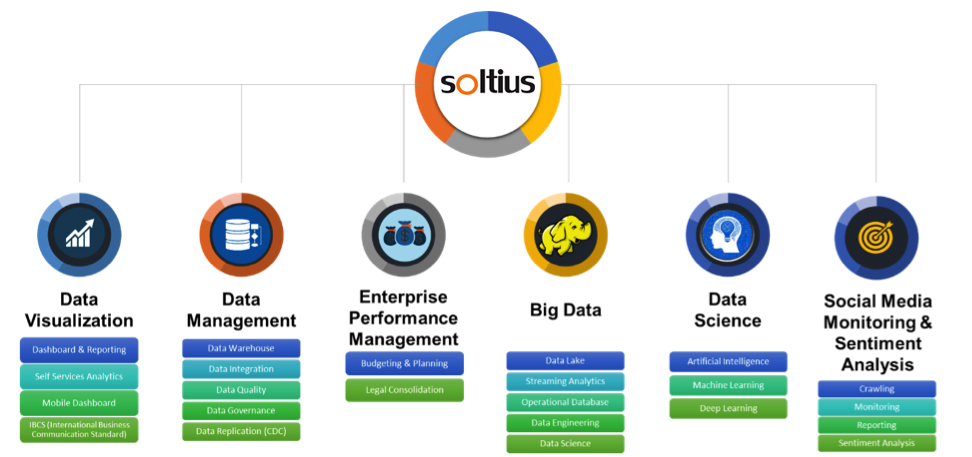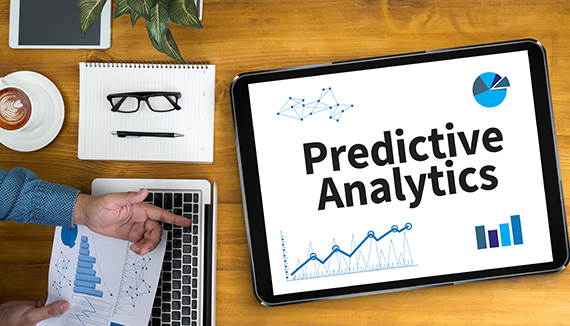PT. Soltius Indonesia Analytics Division helps companies make better decision by transforming them into Data-Driven Culture Company
Our Analytics Portfolio:

Data Visualization
Soltius Indonesia provides data visualization solutions that help businesses analyze data through interactive dashboards and visualizations. These tools enable users, especially top management, to make accurate business decisions and strategies based on data. The visualizations are designed to be intuitive and user-friendly, making it easier to understand complex data sets
Key Components:
-
Interactive Dashboards: These are dynamic interfaces that display data in real-time, allowing users to interact with the data by drilling down into details, filtering, and customizing views.
-
Charts and Graphs: Various types of charts (bar, line, pie, etc.) and graphs are used to represent data trends, comparisons, and distributions visually.
-
Geospatial Visualizations: Maps and other geospatial tools are used to visualize data with a geographical component, helping in location-based analysis.
-
Custom Reports: Tailored reports that meet specific business needs, providing insights into particular areas of interest.
-
Data Integration: Combining data from multiple sources into a single visualization platform to provide a comprehensive view.
Benefits:
-
Enhanced Decision-Making: By presenting data visually, it becomes easier for decision-makers to understand complex information and make informed decisions.
-
Improved Data Comprehension: Visual representations help in quickly grasping patterns, trends, and outliers in data.
-
Increased Engagement: Interactive and visually appealing dashboards and reports engage users more effectively than static reports.
-
Real-Time Insights: Real-time data visualization allows businesses to monitor performance and respond to changes promptly.
-
Accessibility: Visualizations make data accessible to a broader audience, including those who may not have a technical background.
Soltius Indonesia leverages tools like SAP Analytics Cloud and SAP BusinessObjects to provide these data visualization solutions, ensuring that businesses can transform their data into actionable insights.
Data Lakehouse
Soltius Indonesia integrates SAP with Huawei's Data Lakehouse solution to offer a unified platform that combines the benefits of data lakes and data warehouses. This setup allows for seamless real-time data integration, enabling businesses to utilize both structured and unstructured data effectively. The Data Lakehouse supports advanced analytics and decision-making processes by providing a comprehensive view of all data.
Key Components:
-
Unified Storage: Combines the scalability of data lakes with the performance of data warehouses, allowing for the storage of large volumes of diverse data types.
-
Real-Time Data Integration: Utilizes tools like SNP Glue to enable real-time data replication and integration from various sources, including SAP systems
-
Advanced Analytics: Supports advanced analytics and machine learning directly on the data stored in the lakehouse, providing deeper insights and predictive capabilities.
-
Data Governance: Ensures data quality, security, and compliance through robust data governance frameworks.
-
Scalability and Flexibility: Offers scalable storage and compute resources, making it adaptable to changing business needs.
Benefits:
-
Cost Efficiency: Reduces the need for separate data storage and processing systems, lowering overall costs.
-
Improved Performance: Enhances query performance and data processing speeds by leveraging the strengths of both data lakes and data warehouses.
-
Simplified Architecture: Provides a single platform for all data needs, simplifying data management and reducing complexity.
-
Enhanced Data Accessibility: Makes data more accessible to various business units, enabling better decision-making and collaboration.
-
Real-Time Insights: Facilitates real-time data processing and analytics, allowing businesses to respond quickly to changing conditions.
Soltius Indonesia has successfully implemented Data Lakehouse solutions for clients like PT Garudafood, modernizing their data platform using real-time data replication from SAP to a Cloud Data Lakehouse on Google Cloud Platform (GCP)
Data Science (AI/ML/DL/Generative AI)
Soltius Indonesia partners with leading AI platforms to deliver advanced AI solutions, including machine learning (ML), deep learning (DL), and generative AI. These solutions help businesses predict future trends, optimize operations, and enhance customer experiences through personalized recommendations. The AI solutions are designed to be scalable and adaptable to various business needs.
Artificial Intelligence (AI)
AI refers to the simulation of human intelligence in machines that are programmed to think and learn. Soltius Indonesia uses AI to automate processes, enhance decision-making, and improve customer experiences. AI applications include:
-
Chatbots and Virtual Assistants: Automating customer service and support.
-
Predictive Analytics: Forecasting future trends and behaviors based on historical data.
-
Natural Language Processing (NLP): Understanding and processing human language to improve communication between humans and machines.
Machine Learning (ML)
ML is a subset of AI that involves training algorithms to learn from and make predictions or decisions based on data. Soltius Indonesia implements ML to:
-
Enhance Operational Efficiency: Automating routine tasks and optimizing processes.
-
Personalize Customer Experiences: Providing tailored recommendations and services.
-
Detect Anomalies: Identifying unusual patterns that may indicate fraud or other issues.
Deep Learning (DL)
DL is a subset of ML that uses neural networks with many layers (deep networks) to analyze various factors of data. Soltius Indonesia applies DL to:
-
Image and Speech Recognition: Enabling systems to recognize and interpret visual and auditory data.
-
Advanced Analytics: Providing deeper insights through complex data analysis.
-
Autonomous Systems: Developing self-learning systems that can operate independently.
Generative AI
Generative AI involves creating new content or data that is similar to existing data. Soltius Indonesia uses generative AI for:
-
Content Creation: Generating text, images, and other media.
-
Design and Prototyping: Creating new designs and prototypes based on existing patterns.
-
Data Augmentation: Enhancing datasets by generating additional data points.
Soltius Indonesia partners with leading AI platforms to deliver these solutions, ensuring they are scalable and adaptable to various business needs.
Data Integration (ETL, ELT, CDC)
Soltius Indonesia offers end-to-end data integration solutions, including Extract, Transform, Load (ETL), Extract, Load, Transform (ELT), and Change Data Capture (CDC). These solutions automate the processes of data extraction, transformation, and loading, ensuring high-quality data for real-time analytics. The integration solutions help businesses consolidate data from various sources, improving data accuracy and accessibility.
Extract, Transform, Load (ETL)
-
Extract: Data is extracted from various sources, such as databases, applications, and files.
-
Transform: The extracted data is cleaned, formatted, and transformed to meet the requirements of the target system.
-
Load: The transformed data is loaded into a target database or data warehouse for analysis and reporting.
Benefits:
-
Data Quality: Ensures that data is accurate, consistent, and reliable.
-
Centralized Data: Consolidates data from multiple sources into a single repository.
-
Improved Analytics: Provides high-quality data for better insights and decision-making.
Extract, Load, Transform (ELT)
-
Extract: Data is extracted from various sources.
-
Load: The extracted data is loaded directly into the target system.
-
Transform: Data transformation occurs within the target system, leveraging its processing power.
Benefits:
-
Efficiency: Reduces the time required for data processing by leveraging the target system's capabilities.
-
Scalability: Easily handles large volumes of data.
-
Flexibility: Allows for more complex transformations and analytics.
Change Data Capture (CDC)
-
Real-Time Data Replication: Captures and replicates changes made to the source data in real-time.
-
Data Synchronization: Ensures that the target system is always up-to-date with the latest changes from the source.
-
Minimal Impact: Has minimal impact on the source system's performance.
Benefits:
-
Real-Time Analytics: Provides up-to-date data for real-time decision-making.
-
Reduced Latency: Minimizes the delay between data changes and their availability in the target system.
-
Enhanced Data Accuracy: Ensures that the target system reflects the most current data.
Soltius Indonesia uses tools like SAP BusinessObjects Data Services and SNP Glue to implement these data integration solutions, ensuring seamless data flow and high-quality data for analytics.
Social Media Analytics (Sentiment Analysis)
Soltius Indonesia's social media and sentiment analytics solutions help businesses analyze data from social media platforms like Facebook, Twitter, and YouTube. These tools provide insights into customer sentiments and trends, enabling businesses to make informed decisions and improve their social media strategies. The sentiment analysis tools classify social media comments and mentions as positive, negative, or neutral, helping businesses understand customer perceptions.
Key Components:
-
Data Collection: Gathering data from various social media platforms such as Facebook, Twitter, YouTube, and web forums. This includes posts, comments, likes, shares, and other interactions.
-
Sentiment Analysis: Using natural language processing (NLP) and machine learning algorithms to classify social media content as positive, negative, or neutral. This helps businesses understand customer emotions and opinions.
-
Trend Analysis: Identifying trends and patterns in social media data to understand what topics are gaining traction and how public sentiment is evolving over time.
-
Engagement Metrics: Measuring engagement levels, such as the number of likes, shares, comments, and mentions, to gauge the effectiveness of social media campaigns.
-
Influencer Analysis: Identifying key influencers and opinion leaders who have a significant impact on brand perception and customer behavior.
Benefits:
-
Customer Insights: Provides a deeper understanding of customer preferences, needs, and pain points, enabling businesses to tailor their products and services accordingly.
-
Brand Monitoring: Helps in tracking brand mentions and sentiment, allowing businesses to respond promptly to customer feedback and manage their online reputation.
-
Competitive Analysis: Offers insights into competitors' social media strategies and performance, helping businesses identify opportunities and threats.
-
Improved Marketing Strategies: Enables businesses to optimize their social media marketing efforts by understanding what content resonates with their audience.
-
Real-Time Feedback: Provides real-time insights into customer reactions and opinions, allowing businesses to make timely adjustments to their strategies.
Soltius Indonesia's social media and sentiment analytics solutions help businesses analyze data from platforms like Facebook, Twitter, and YouTube, providing valuable insights into customer sentiments and trends.

Business Intelligence (BI)
Complete package of Business Intelligence solution from Software, Professional services, Hardware, Annual maintenance contract, managed services and outsourcing services for these products: SAP Analytics Cloud (SAC) & SAP Business Objects Enterprise for Business Intelligence

Data Management
End to end solution for data integration or Extract Transform and Loading solution using SAP BW built in ETL (Process Chain), SAP Business Objects Data Services and professional services for other data integration platform.

Enterprise Performance Management (EPM)
Enterprise performance management (EPM) solutions help increase revenue and profitability by allowing you to better strategize and plan, analyse and optimize, and close and disclose results.

Big Data
Soltius Indonesia collaborate with Mitra Integrasi Informatika deliver the best solution for hadoop based big data platform using Cloudera

SAP Predictive Analytics
PT. Soltius Indonesia provides predictive analytics using SAP Predictive Analytics and open source software R studio. We recommend that customer should ensure they already have data platform such as data warehouse, data quality or big data to be used as the data source for predictive application. It depends on the quality of your data to predict the best future outcome.

Demand Forecasting
PT. Soltius Indonesia provides demand forecasting service for any Industry. With this system you will get better forecast accuracy to give better support to the company in taking decision of production, distribution, and supply planning


